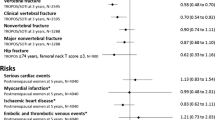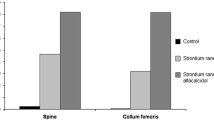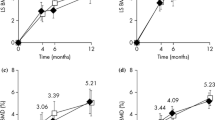Abstract
The aim of the PREVOS study (PREVention Of early postmenopausal bone loss by Strontium ranelate) and the STRATOS study (STRontium Administration for Treatment of OSteoporosis) was to determine the minimum dose at which strontium ranelate (SR) is effective in, respectively, the prevention of bone loss in early postmenopausal nonosteoporotic women and the treatment of postmenopausal vertebral osteoporosis. Both studies were randomized, double-blind, placebo-controlled, dose-finding studies in parallel groups and lasted 2 years. In the PREVOS study, 160 early postmenopausal women were randomized to receive placebo, SR 125 mg/day, 500 mg/day or 1 g/day. In the STRATOS study, 353 osteoporotic postmenopausal women with at least one previous vertebral fracture and a lumbar T-score <−2.4 were randomized to receive placebo, SR 500 mg/day, 1 g/day or 2 g/day. In both studies, the primary efficacy parameter was lumbar bone mineral density (BMD) measured by dual-energy X-ray absorptiometry. Secondary efficacy criteria included incidence of new vertebral deformities (in the STRATOS study only) and biochemical markers of bone metabolism. In the PREVOS study, the increase in lumbar BMD from baseline in the 1 g/day group (+5.53%) was significantly different from the decrease in the placebo group (p<0.001). In the STRATOS study, the annual increase in lumbar BMD in the 2 g/day group (+7.3% per year) was significantly higher than in the placebo group (p<0.001). There was a significant reduction in the number of patients experiencing new vertebral deformities in the second year of treatment in the 2 g/day group (relative risk: 0.56; 95% confidence interval: 0.35, 0.89). In both studies, there was a significant increase in the bone formation marker (bone alkaline phosphatase) in the higher-dose group. Urinary excretion of the marker of bone resorption (cross-linked N-telopeptide) was lower with SR than with placebo in the STRATOS study. SR was very well tolerated in both studies. The minimum dose at which SR is effective in preventing bone loss in early postmenopausal nonosteoporotic women and in the treatment of postmenopausal osteoporosis is 1 g/day and 2 g/day, respectively.

Similar content being viewed by others
References
Parfitt AM, Mundy GR, Roodman GD, et al. A new model for the regulation of bone resorption, with particular reference to the effects of bisphosphonates. J Bone Miner Res 1996;11:1509.
Eastell R. Treatment of postmenopausal osteoporosis. N Engl J Med 1998;338:736–46.
Neer R, Arnaud C, Zanchetta J, et al. Effect of parathyroid hormone (1–34) on fractures and bone mineral density in postmenopausal women with osteoporosis. N Engl J Med 2001;344:1434–41.
Arlot ME, Roux JP, Boivin G, et al. Effects of strontium salt (S 12911) in both tibial metaphysis and epiphysis in normal growing rats [abstract]. J Bone Miner Res. 1995;10(Suppl 1):abstr M415.
Canalis E, Hott M, Deloffre P, Tsouderos Y, Marie PJ. The divalent salt S 12911 enhances bone cell replication and bone formation in vitro. Bone 1996;18:517–23.
Baron R, Tsouderos Y. In vitro effects of S12911–2 on osteoclast function and bone marrow macrophage differentiation. Eur J Pharmacol 2002;450:11–7.
Marie PJ, Hott M, Modrowski D, et al. An uncoupling agent containing strontium prevents bone loss by depressing bone resorption and maintaining bone formation in estrogen-deficient rats. J Bone Miner Res 1993;8:607–15.
Amman P, Robin B, Bonjour JP, et al. Long-term exposure to strontium ranelate dose-dependently increases bone strength in intact female rats [abstract]. Bone 2001;5(Suppl):S220.
Delannoy P, Bazot D, Marie PJ. Long-term treatment with strontium ranelate increases vertebral bone mass without deleterious effect in mice. Metabolism 2002;51:906–11.
Marie PJ. Effects of strontium on bone formation and bone cells. In: Neve J, editor. Therapeutic use of trace elements. New York: Plenum Press, 1996:277–82.
Boivin G, Deloffre P, Perrat B, et al. Strontium distribution and interactions with bone mineral in monkey iliac bone after strontium salt (S12911) administration. J Bone Miner Res 1996;11:1302–11.
Slosman DO, Provvedini DM, Meunier PJ, et al. The use of different dual X-ray absorptiometry brand in a multicenter clinical trial. J Clin Densitom 1999;2:37–44.
Reginster JY, Lecart MP, Deroisy R, et al. Prevention of postmenopausal bone loss by tiludronate. Lancet 1989;II:1469–71.
Hosking D, Chilvers CE, Christiansen C, et al. Prevention of bone loss with alendronate in postmenopausal women under 60 years of age. Early postmenopausal Intervention Cohort Study Group. N Engl J Med 1998;338:485–92.
Ravn P, Bidstrup M, Wasnich RD, et al. Alendronate and estrogen-progestin in the long-term prevention of bone loss: four-year results from the early postmenopausal intervention cohort study. A randomized, controlled trial. Ann Intern Med 1999;131: 935–42.
Meunier PJ, Confavreux E, Tupinon I, et al. Prevention of early postmenopausal bone loss with cyclical etidronate therapy (a double-blind, placebo-controlled study and 1-year follow-up). J Clin Endocrinol Metab 1997;82: 2784–91.
Adami S, Bruni V, Bianchini D, et al. Prevention of early postmenopausal bone loss with cyclical etidronate. J Endocrinol Invest 2000;23: 310–6.
Reginster JY, Deroisy R, Dougados M, et al. Prevention of early postmenopausal bone loss by strontium ranelate: the randomized two-year, double-masked, dose-ranging, placebo, controlled PREVOS trial. Osteoporos Int 2002;13: 925–31.
Meunier PJ, Slosman DO, Delmas PD, et al. Strontium ranelate: dose-dependent effects in established postmenopausal vertebral osteoporosis: the STRATOS 2-year randomized placebo controlled trial. J Clin Endocrinol Metab 2002;87: 2060–6.
Lufkin EG, Wahner HW, O'Fallon WM, et al. Treatment of postmenopausal osteoporosis with transdermal estrogen. Ann Intern Med 1992;117:19.
Storm T, Thamsborg G, Steiniche T, et al. Effect of intermittent cyclical etidronate therapy on bone mass and fracture rate in women with postmenopausal osteoporosis. N Engl J Med 1990;322:1265–71.
CPMP: Committee for Proprietary Medical Products. Note for guidance on postmenopausal osteoporosis in women. London, January 2001. CPMP/EWP/559/98.
Food and Drug Administration. Guidelines for preclinical and clinical evaluation of agents used in the prevention or treatment of postmenopausal osteoporosis. USA: Division of Metabolism and Endocrine Drug Products, FDA: 1994.
Ettinger B, Black DM, Mitlak BH, et al. Reduction of vertebral fracture risk in postmenopausal women with osteoporosis treated with raloxifene: results from a 3-year randomized clinical trial. JAMA 1999;282:637–45.
Liberman UA, Weiss SR, Broll J, et al. Effect of oral alendronate on bone mineral density and the incidence of fractures in postmenopausal osteoporosis. The Alendronate Phase III Osteoporosis Treatment Study. N Engl J Med 1995;333:1437–43.
Cranney A, Guyatt G, Krolocki N, et al. A meta-analysis of etidronate for the treatment of postmenopausal osteoporosis. Osteoporos Int 2001;12:140–51.
Reginster JY, Minne HW, Sorensen OH, et al. Randomized trial of the effects of risedronate on vertebral fractures in women with established postmenopausal osteoporosis. Vertebral Efficacy with Risedronate Therapy (VERT) Study Group. Osteoporos Int 2000;11:83–91.
Boivin G, Schenker E, Tupinon-Mathieu I, et al. Uptake and distribution of strontium in human bone, evolution of the degree of mineralisation after strontium ranelate administration. J Bone Miner Res 1999;14(Suppl 1):284.
Meunier PJ, Roux C, Ortolani S, et al. Strontium ranelate reduces the vertebral fracture risk in women with postmenopausal osteoporosis. Osteoporos Int 2002;13(Suppl 1):O45.
Acknowledgements
The following investigators participated in the trial: Belgium: J.Y. Reginster, Liège; P. Geusens and I Dequeker, Diepenbeek/Pellenberg. Denmark: S. Pors Nielsen, Hillerød; O.H. Sørensen, Copenhagen. France: P.J. Meunier, Lyon; C. Roux, Paris; C. Alexandre, St Etienne; M. Audran, Angers; C.L. Benhamou, Orléans; P. Bourgeois, Paris; A. Daragon, Rouen; D. Goldberg and D. Kuntz, Paris; Y. Pawlotsky, Rennes; J.M. Ristori, Clermont-Ferrand; D. Rolland, Bourges; C. Zarnitsky, Le Havre; G. Ziegler, Nice. Germany: E. Minne, Bad-Pyrmont; Hungary: J. Szucs and G. Balint, Budapest. Italy: C.V. Albanese, Rome; M. Passeri, Parma; S. Ortolani, Milan; M.L. Brandi, Florence. Poland: R. Lorenc, Warsaw. Spain: J. Gonzalez, Santander; H. Rico, Madrid; A. Roces, Tenerife. UK: A. Bhalla, Bath; D. Fogelman, London; A. Woolf, Truro.
Author information
Authors and Affiliations
Corresponding author
Rights and permissions
About this article
Cite this article
Reginster, J.Y., Meunier, P.J. Strontium ranelate phase 2 dose-ranging studies: PREVOS and STRATOS studies. Osteoporos Int 14 (Suppl 3), 56–65 (2003). https://doi.org/10.1007/s00198-002-1349-0
Received:
Accepted:
Published:
Issue Date:
DOI: https://doi.org/10.1007/s00198-002-1349-0




